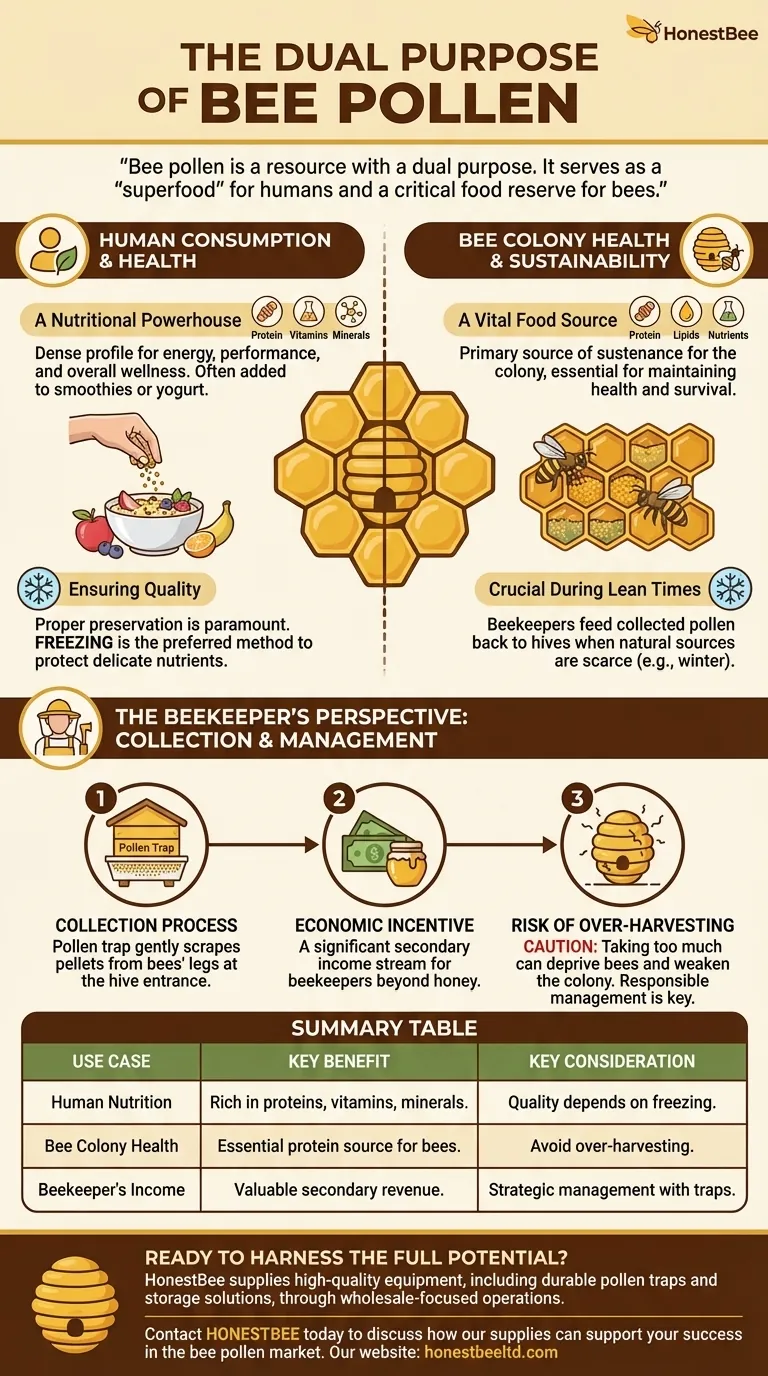The primary uses for bee pollen fall into two distinct categories: for human consumption as a nutritional supplement and as a vital food source to support the health and sustainability of bee colonies themselves. Beekeepers collect this protein-rich substance as a valuable commodity for the health food market and as a tool for effective hive management.
Bee pollen is a resource with a dual purpose. It serves as a "superfood" for humans seeking health benefits and as a critical food reserve for bees, creating a key economic and agricultural opportunity for beekeepers.

The Dual Role of Bee Pollen
Bee pollen's value stems from its dense nutritional profile, making it beneficial for both the species that creates it and the humans who harvest it.
A Nutritional Powerhouse for Humans
Bee pollen is widely marketed and consumed as a health food or "superfood." Its reputation is built on its rich composition of proteins, vitamins, and minerals.
Many people incorporate it into their diets, often in smoothies or on yogurt, with the goal of boosting energy, athletic performance, and overall wellness.
A Vital Food Source for Bees
For a bee colony, pollen is the primary source of protein, lipids, and nutrients. Beekeepers harvest pollen not just to sell, but also to feed back to their own hives.
This practice is crucial for maintaining colony health, especially during periods when natural pollen is scarce, such as over winter or in areas with insufficient floral diversity.
The Beekeeper's Perspective
For beekeepers, collecting pollen is a strategic activity that balances economic opportunity with the responsibility of hive stewardship.
The Economic Incentive
Selling bee pollen provides a significant, secondary stream of income beyond honey production. The demand for pollen in the health and wellness market makes it a profitable venture.
The Collection Process
Harvesting involves fitting a special device called a pollen trap to the hive entrance. This trap gently scrapes the pollen pellets from the bees' legs as they enter.
The Importance of Preservation
Once collected, the pollen must be cleaned of impurities and immediately preserved to maintain its freshness and nutritional value.
Freezing is the preferred method, as it protects the delicate nutrients and allows the pollen to be stored indefinitely without degradation.
Common Pitfalls and Considerations
While beneficial, the collection and use of bee pollen require careful management to avoid negative consequences.
The Risk of Over-Harvesting
A beekeeper must never take too much pollen from a single hive. Doing so can deprive the bees of their essential food source, weakening the colony and making it vulnerable to disease and collapse.
Ensuring Quality for Consumption
For human use, the quality of bee pollen is paramount. Proper preservation, particularly freezing, is essential. Dried pollen can lose some of its nutritional potency if not processed correctly.
Applying This Knowledge
Your approach to bee pollen will depend entirely on your goal, whether you are a consumer or a producer.
- If your primary focus is health and wellness: Seek out fresh or flash-frozen bee pollen to ensure you are getting the most nutritional benefit.
- If your primary focus is sustainable beekeeping: Use pollen collection as a tool to support your colonies during lean times and as a secondary income source, always prioritizing the health of the hive.
Ultimately, understanding bee pollen's dual function as both a human supplement and a cornerstone of colony health is the key to appreciating its true value.
Summary Table:
| Use Case | Key Benefit | Key Consideration |
|---|---|---|
| Human Nutrition | Rich source of proteins, vitamins, and minerals. | Quality depends on proper preservation (freezing is best). |
| Bee Colony Health | Essential protein source for bees, especially in winter. | Avoid over-harvesting to prevent weakening the hive. |
| Beekeeper's Income | Provides a valuable secondary revenue stream. | Requires strategic management with a pollen trap. |
Ready to harness the full potential of bee pollen for your operation?
Whether you manage a commercial apiary or distribute beekeeping equipment, having the right supplies is crucial for successful pollen collection and hive health. HONESTBEE supplies beekeepers and distributors with high-quality equipment, including durable pollen traps and storage solutions, through our wholesale-focused operations.
Contact HONESTBEE today to discuss how our beekeeping supplies can support your success in the growing bee pollen market.
Visual Guide

Related Products
- Professional Galvanized Hive Strap with Secure Locking Buckle for Beekeeping
- Stainless Steel Scraper for Metal Queen Bee Excluders
- Professional Long-Handled Silicone Honey Scraper for Beekeeping
- Retractable Chinese Queen Rearing Grafting Tools Equipment
- Wooden Queen Bee Excluder for Beekeeping
People Also Ask
- What are the two styles of hive straps? Choose the Right Strap for Your Hive Security
- What is the best length for straps used around beehives? Why 12 Feet is the Industry Standard
- Can straps with hook ends be used for beehives? A Guide to Secure Hive Management
- Why are hive straps important for beekeepers? Secure Your Hives Against Wind, Predators & Transport
- How can beekeepers secure the top cover of a hive? Protect Your Colony from Wind and Weather



















